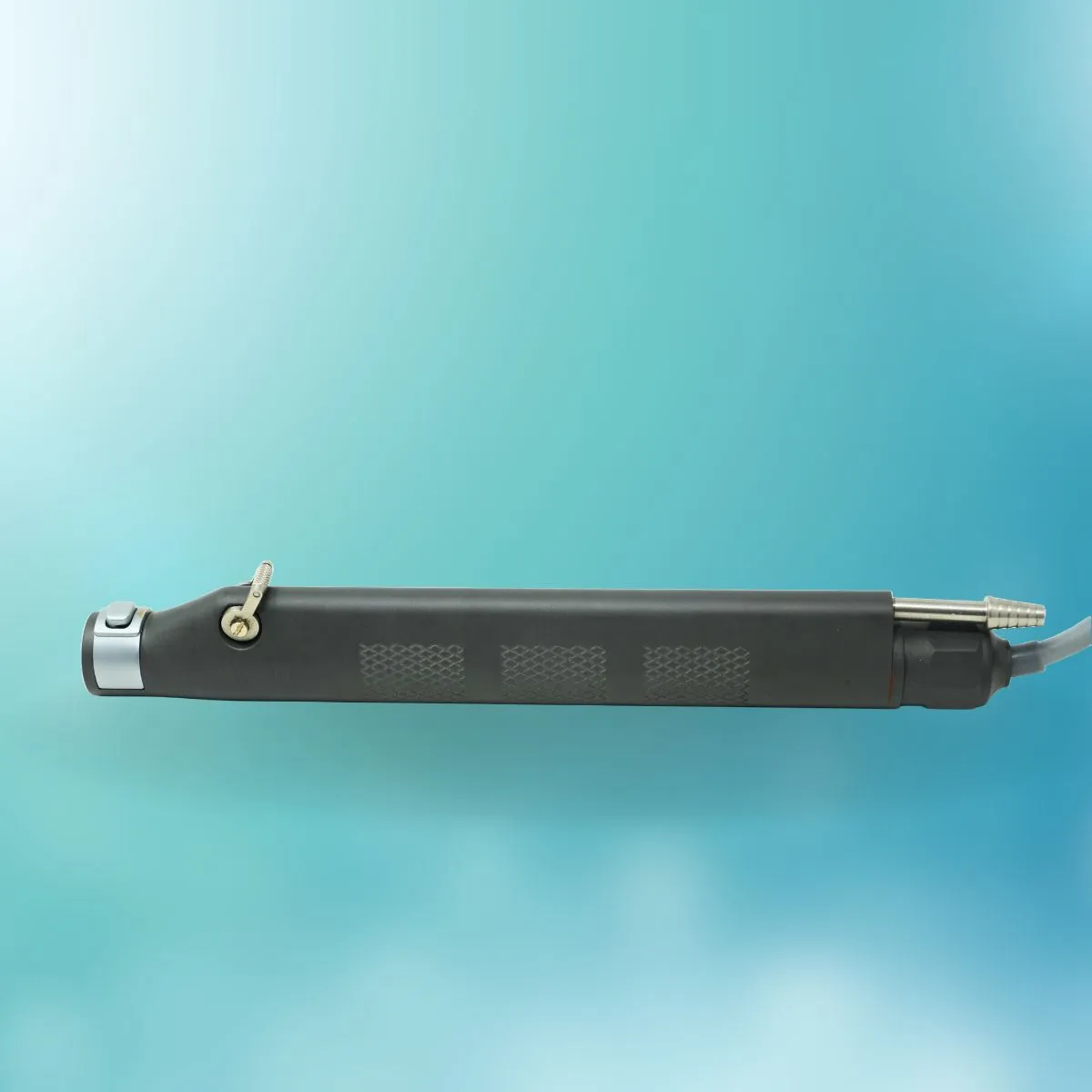MINI SHAVER HAND PIECE
Description
A mini shaver handpiece in arthroscopy is a specialized surgical instrument used to remove or trim soft tissues, cartilage, and bone during minimally invasive joint surgeries. This tool is typically employed in arthroscopic procedures where precision and minimal tissue disruption are critical. The handpiece is designed to be lightweight, ergonomic, and easy to handle, allowing the surgeon to work in confined areas within the joint, such as the knee, shoulder, or hip, with enhanced control and precision.
Function and Mechanism:
The mini shaver handpiece consists of a motorized mechanism that drives a rotating blade or cutting device at high speeds. The blades are designed to cut and shave off damaged or excess tissue, cartilage, or bone with minimal force, which helps to preserve surrounding healthy tissue. The shaver is connected to a suction system that removes debris and fluids from the surgical site, maintaining a clear view for the surgeon throughout the procedure.
-
Rotating Blades: The mini shaver is equipped with rotating blades or burrs that allow the surgeon to precisely trim or debride tissue. These blades can vary in size, shape, and cutting speed, allowing for a range of uses depending on the surgical needs.
-
Suction Mechanism: Most mini shaver handpieces are integrated with a suction system that removes tissue debris and fluid from the joint during surgery. This helps maintain a clean surgical field, ensuring that the surgeon has continuous, clear visualization of the area being treated.
-
Versatile Use: The mini shaver can be used for a variety of orthopedic procedures, including cartilage debridement, ligament and tendon repair, and bone shaving, making it an essential tool for joint preservation and restoration surgeries.
Applications in Orthopedic Surgery:
-
Cartilage Debridement: One of the primary uses of the mini shaver is to remove damaged or degenerated cartilage in the joint. This is particularly common in the treatment of osteoarthritis, where the shaver helps remove worn cartilage to allow for joint resurfacing or to prepare the area for surgical repair.
-
Soft Tissue Removal: The mini shaver is commonly used to trim or remove soft tissue such as damaged ligaments or tendons. It is particularly effective in arthroscopic rotator cuff repairs or meniscal tears, where precision is key in removing only the damaged tissue without harming surrounding healthy tissue.
-
Bone Shaving: In some cases, the mini shaver is used for bone shaving, especially in joint procedures where the surgeon needs to smooth out rough edges or remove small bone spurs that might cause discomfort or restrict movement.
-
Joint Resurfacing: For joint resurfacing procedures, the mini shaver handpiece allows the surgeon to remove damaged cartilage or bone to prepare the joint for prosthetic implants or cartilage grafting.
-
Meniscus Repair: The mini shaver is often used in knee surgeries, particularly during meniscus repair procedures, to remove frayed or torn edges of the meniscus, helping the surgeon create a cleaner, healthier environment for healing.
Benefits:
-
Minimally Invasive: The use of a mini shaver in arthroscopy allows for minimally invasive surgeries with smaller incisions, which reduces patient trauma, decreases scarring, and promotes faster healing.
-
Precision and Control: The handpiece is designed for easy manipulation, providing the surgeon with fine control over tissue removal. This precision helps in performing delicate repairs, minimizing the risk of damaging healthy tissues.
-
Clear Visualization: The integration of suction in the mini shaver handpiece ensures that the surgical site remains free of debris and fluid, improving visualization of the joint and enhancing the surgeon’s ability to perform accurate procedures.
-
Versatility: The mini shaver can be used across a range of orthopedic surgeries, including cartilage debridement, soft tissue trimming, and bone shaving, making it a versatile tool for various joint procedures.
-
Improved Patient Recovery: Because the mini shaver is used in minimally invasive procedures, patients typically experience reduced pain, faster recovery times, and fewer complications than traditional open surgeries.
Considerations:
-
Blade Selection: The surgeon must select the appropriate blade type based on the tissue being treated, as different tissues, such as cartilage, tendon, or bone, may require different cutting tools.
-
Speed Control: It’s essential to adjust the speed of the mini shaver to match the surgical procedure and the tissue being treated. Excessive speed may cause tissue damage, while too slow a speed may be inefficient.
-
Sterilization: As a reusable device, the mini shaver handpiece must be thoroughly cleaned and sterilized between uses to prevent infection and ensure optimal performance.
-
Potential for Tissue Damage: If not handled properly, the mini shaver can damage surrounding tissues. Surgeons need to be cautious when working near critical structures such as blood vessels or nerves.
Conclusion:
The mini shaver handpiece is an invaluable tool in orthopedic arthroscopic surgeries, offering precision and versatility in removing or trimming soft tissues, cartilage, and bone. By enabling surgeons to perform minimally invasive procedures with high accuracy, the mini shaver enhances surgical outcomes, reduces patient trauma, and promotes faster recovery. Its integration with suction systems and its ability to work in tight, confined spaces make it an essential instrument for joint preservation and restoration surgeries. Whether for cartilage debridement, soft tissue removal, or bone shaving, the mini shaver handpiece plays a key role in improving the quality of orthopedic care.


